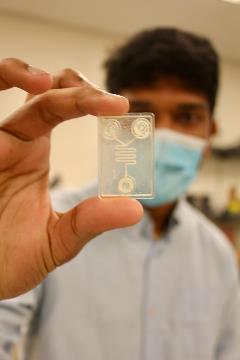Findings Staff Report | Oct. 12, 2020
This time last year, as chemical engineer and University of Cincinnati professor Aashish Priye worked to build a simpler, more portable diagnostic tool in his lab at UC, he imagined it would help people in remote areas, far from hospitals, during some sort of infectious disease outbreak.
Then the new coronavirus swept across the globe. Carrying with it an immediate need for at-home testing in every home, everywhere.
Priye and the UC students in his lab quickly turned their attention to COVID-19, exploring how they might create a smartphone-based DNA analyzer that could theoretically allow someone to test themselves for COVID-19.
“The University of Cincinnati is the leading R1 urban university in our region with unrivaled talent solving problems that matter, like this one” says UC Vice President for Research Pat Limbach. “Bringing solutions directly to those people impacted, such as the work being done by Dr. Priye and his team, can transform the world.”

Priye is heading up one of 13 research teams, each awarded a phase-one $10,000 planning grant last year in the Digital Futures Anchor Development Program from the Office of Research. The anchor teams will carry on their research inside the new Digital Futures space, when it opens in 2022.
Priye came to UC after earning a doctorate in chemical engineering from Texas A&M University in 2015 and spending three years as a postdoctoral fellow at Sandia National Laboratories in California, where he worked on a smartphone-based diagnostic platform for rapid detection of Zika, dengue and chikungunya viruses.
Broadly, his lab focuses on the science and engineering of microfluidics, which studies the behavior of fluids through micro-channels and the technology of manufacturing microminiaturized devices. These so called lab-on-chip systems have many possible applications beyond portable devices for point-of-care diagnostics, including environmental sampling and genetic analysis.
“I was drawn to work in Dr. Priye’s lab because he is working on something that is new and different and important for society,” says Salar Balou, a second-year graduate student. “It could truly help so many people directly from their homes.”
Priye is focused on perfecting a process known as LAMP—loop-mediated isothermal amplification
It could one day be an alternative to the current process of pathogen detection called polymerase chain reaction (PCR), which has been used for more than 30 years and is mostly done in a lab.
“Today’s gold standard PCR system is a bulky machine that uses a lot of power—we know this can be improved,” Priye says. “Our work is curiosity driven—we aim to create the next generation of microfluidic devices using rapid micro-fabrication techniques.”
To see the work through, Priye continues to build working relationships with other UC researchers studying medicine, artificial intelligence and machine learning. One day LAMP could be accurately used on a smartphone—by simply taking a photo of the sample chip—and the LAMP device could be flown to remote location on a drone for quicker results.
The Digital Futures Initiative is geared directly towards these use-inspired, application-based research challenges, says Limbach.
“The University of Cincinnati is building an incredible interdisciplinary web of research,” Priye says. “It’s a great platform for new discovery.”